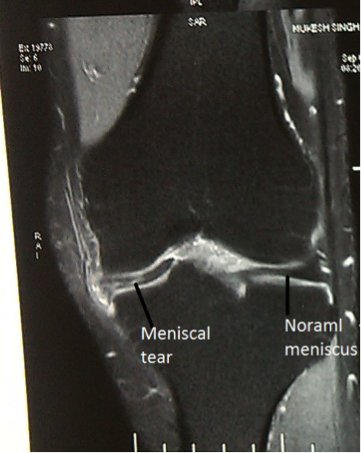Meniscus Tear and Treatment
Anatomy: The menisci are the wedge shaped cushion like discs (made primarily of type I collagen) that are sandwiched between the opposing thigh and leg bones. There are two menisci in the each knee joint, outer (lateral) and inner (medial). These menisci derive their nutrition primarily from synovial fluid (fluid that is present in the knee joint). Each meniscus has three parts namely a posterior horn, a body and an anterior horn. The inner meniscus is elliptical and larger in size than the outer meniscus which is more circular in shape and has the greater surface area.

Why these menisci are important?
Menisci are elastic structures and they act as shock absorbers in the knee joint and protect the joint cartilage (glistening surface of opposing thigh and leg bones). They are also important in keeping the thigh bone fit into leg bone. Menisci help in maintaining joint congruity and maximize contact area between leg bone (tibia) and thigh bone (femur).
What causes a meniscus tear?
In young patients meniscus tear are mostly due to twisting injury to the knee joint. In old persons these are mostly due to age related degenerative changes. Abnormalities of meniscus like abnormal shape (Discoid meniscus) or meniscal cyst also make menisci more prone to injury. Inner meniscus is less mobile than outer hence tear of inner meniscus are more common.

Can all meniscus tear be repaired?
Only peripheral 10-25% width of menisci has blood supply. This outer or peripheral zone is known as red-red zone. Inner 1/3rd width of menisci has no blood vessels. This is known as white-white zone. In between these two zones (red-white zone) a few blood vessels may present. Only tears of red-red zone, and a few tears of red-white have healing potential and can be repaired. A majority of meniscal tears are present in white-white zone and can’t be repaired. All tears of white-white zone and most of the tears of red-white zone need resection.
Signs and Symptoms
Pain and recurrent swelling are common features. Often a torn piece of meniscus entrapped in the joint gives a clicking sound and pain on knee bending as would occur in climbing up or down the stairs. At times, the torn part can be trapped in between the leg and thigh bones and may prevent leg bone from straightening. This condition is called locking of the knee. A locked knee may require manipulation by the patient or the doctor.
How meniscal tears are treated?
Meniscal tears are diagnosed by clinical examination and confirmed by MRI. Fresh tears, small tears and tears of peripheral red-red zone can be repaired. In meniscal repair torn parts are sutured together. Old tears, tears of white-white zone, degenerative tears and complex tears are usually trimmed away. All meniscal surgeries are key hole surgeries and done arthroscopically (minimally invasive).
SPECIALITIES
OPENING HOURS
| Monday – Friday | 17:00 – 20:00 |
| Sunday | By Appointment Only |
+91-7357406805
CLINIC LOCATIONS
OUR PATIENTS SAY
We’re proud to receive some exceptional compliments from our patients and their family members. We fell very happy and blessed to see our patients recover.

मेरा दाए पैर में चोट लगने के कारण टेढ़ा हो गया था जिसकी वजह से मुझे चलने में भी परेशानी हो रही थी. डॉ जितेश ने ऑपरेशन कर के इसे सीधा किया. में बिलकुल ठीक हूँ .

Dr. Jain came out from his clinic to see my mother because my mother was not able walk a single step. He did total knee replacement on both side and now my mother is walking without aid.

मेरी बेटी के घुटने में इन्फेक्शन होने के कारण वो दर्द की वजह से सो भी नहीं पाती थी. डॉ जितेश ने ऑपरेशन कर के इसे ठीक किया. बहुत धन्यवाद।
